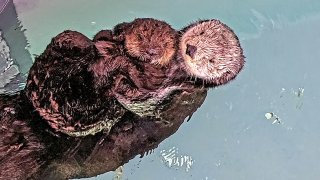
An orphaned sea otter pup found a new home at the Aquarium of the Pacific in Long Beach after being rescued off the coast of Santa Cruz County, officials announced Thursday.
Officials said the female sea otter pup will be the first "surrogate-raised" otter at the facility, for potential release back to the wild, as part of a partnership with the Monterey Bay Aquarium Sea Otter Surrogacy Program. The pup has been paired with an adult female sea otter at the facility with the intention of teaching the baby skills such as foraging and grooming their thick fur needed to survive and thrive in the wild.
"We are thrilled to be able to further help this threatened species recover by expanding our conservation programs to now help stranded sea pups get a second chance at returning to the wild," Brett Long, senior director of birds and mammals at the Aquarium of the Pacific, said in a statement.
The Aquarium of the Pacific has taken in rescued sea otters deemed non-releasable to the wild by the U.S. Fish and Wildlife Service since it opened in 1998. The aquarium joined Monterey's program in 2020, and helped build a "behind-the-scenes" facility for surrogate mothers and orphaned pups.
Get Southern California news, weather forecasts and entertainment stories to your inbox. Sign up for NBC LA newsletters.
The surrogacy area is part of the Molina Animal Care Center, and can accommodate three to four rescued sea otter pups each year. The facility is kept away from the public to limit human interaction, in an effort to increase the pups' chances of survival in the wild.
The California's Coastal Conservancy Sea Otter Recovery Grant Program supported the initial construction of the sea otter surrogacy facility. Videos of rescued pups and signage are located outside of the surrogacy facility to educate the aquarium's visitors on the program and the significance of recovering southern sea otter populations.
"We've been working with our partners at the Aquarium of the Pacific for more than three years to reach this moment, and we're excited they're now ready to welcome orphaned pups for surrogacy,'' Jessica Fujii, manager of the Sea Otter Program at Monterey Bay Aquarium, said in a statement. "Sea otters help maintain the health of kelp forests and wetlands on California's coast. This milestone is advancing our work to help sea otters recover from being hunted to near extinction and help strengthen our coastal ecosystems."
Local
Get Los Angeles's latest local news on crime, entertainment, weather, schools, COVID, cost of living and more. Here's your go-to source for today's LA news.
"The Aquarium of the Pacific also has a public fundraising campaign to support its work with rescued sea otter pups through this program.
Southern sea otters are marine mammals in the weasel family. They are currently found along the North American west coast from Half Moon Bay just south of San Francisco to Point Conception in Santa Barbara County, a fraction of their historical range.
Sea otters play the important role of ecosystem engineer for their ocean habitats. Sea otters were hunted to near extinction in the early 1900s. Now a protected species, California's sea otters have grown from a group of fifty in 1938 to nearly 3,000 today. Despite this progress, their population growth has stalled in recent years and they continue to face serious risks, including oil spills, pollution and climate change, according to the Aquarium of the Pacific.
Through its Pacific Visions area, visitors to the Aquarium of the Pacific can learn how climate change is impacting the ocean, its inhabitants and people, along with what can be done to work toward a more sustainable future. The aquarium also serves as a facility for rehabilitating and releasing sea turtles, raising endangered mountain yellow-legged frogs for release, and spawning and releasing endangered white abalone.



